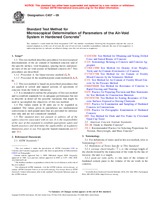Potrebujeme váš súhlas na využitie jednotlivých dát, aby sa vám okrem iného mohli ukazovať informácie týkajúce sa vašich záujmov. Súhlas udelíte kliknutím na tlačidlo „OK“.
ASTM C457-09
Standard Test Method for Microscopical Determination of Parameters of the Air-Void System in Hardened Concrete
Automaticky preložený názov:
Štandardná skúšobná metóda pre mikroskopického stanovenia parametrov Air - Void systému v stvrdnutý betón
NORMA vydaná dňa 1.7.2009
Informácie o norme:
Označenie normy: ASTM C457-09
Poznámka: NEPLATNÁ
Dátum vydania normy: 1.7.2009
Kód tovaru: NS-13483
Počet strán: 15
Približná hmotnosť: 45 g (0.10 libier)
Krajina: Americká technická norma
Kategória: Technické normy ASTM
Anotácia textu normy ASTM C457-09 :
Keywords:
air content, air void parameters of hardened concrete, area-prepared surface required, average chord-length of voids, determination of air-void parameters, entrained void, entrapped void, grits for lapping hardened concrete, index point, lapping, length of traverse required, linear-traverse method, microscopical, number of points required, paste-air ratio, paste-air ratio modification, paste content, point-count method (modified), sample preparation for microscopical analysis, spacing factor
Doplňujúce informácie
| Significance and Use | ||||||||||||||||||||||||
|
The parameters of the air-void system of hardened concrete determined by the procedures described in this test method are related to the susceptibility of the cement paste portion of the concrete to damage by freezing and thawing. Hence, this test method can be used to develop data to estimate the likelihood of damage due to cyclic freezing and thawing or to explain why it has occurred. The test method can also be used as an adjunct to the development of products or procedures intended to enhance the resistance of concrete to cyclic freezing and thawing (1). Values for parameters of the air-void system can be obtained by either of the procedures described in this test method. No provision is made for distinguishing among entrapped air voids, entrained air voids, and water voids. Any such distinction is arbitrary, because the various types of voids intergrade in size, shape, and other characteristics. Reports that do make such a distinction typically define entrapped air voids as being larger than 1 mm in at least one dimension being irregular in shape, or both. The honey-combing that is a consequence of the failure to compact the concrete properly is one type of entrapped air void (9, 10). Water voids are cavities that were filled with water at the time of setting of the concrete. They are significant only in mixtures that contained excessive mixing water or in which pronounced bleeding and settlement occurred. They are most common beneath horizontal reinforcing bars, pieces of coarse aggregate and as channelways along their sides. They occur also immediately below surfaces that were compacted by finishing operations before the completion of bleeding. Application of the paste-air ratio procedure is necessary when the concrete includes large nominal maximum size aggregate, such as 50 mm (2 in.) or more. Prepared sections of such concrete should include a maximum of the mortar fraction, so as to increase the number of counts on air voids or traverse across them. The ratio of the volume of aggregate to the volume of paste in the original mix must be accurately known or estimated to permit the calculation of the air-void systems parameters from the microscopically determined paste-air ratio. Note 1—The air-void content determined in accordance with this test method usually agrees closely with the value determined on the fresh concrete in accordance with Test Methods C 138/C 138M, C 173/C 173M, or C 231 (11). However, significant differences may be observed if the sample of fresh concrete is consolidated to a different degree than the sample later examined microscopically. For concrete with a relatively high air content (usually over 7.5 %), the value determined microscopically may be higher by one or more percentage points than that determined by Test Method C 231. |
||||||||||||||||||||||||
| 1. Scope | ||||||||||||||||||||||||
|
1.1 This test method describes procedures for microscopical determinations of the air content of hardened concrete and of the specific surface, void frequency, spacing factor, and paste-air ratio of the air-void system in hardened concrete (1). Two procedures are described: 1.1.1 Procedure A, the linear-traverse method (2, 3). 1.1.2 Procedure B, the modified point-count method (3, 4, 5, 6). 1.2 This test method is based on prescribed procedures that are applied to sawed and lapped sections of specimens of concrete from the field or laboratory. 1.3 It is intended to outline the principles of this test method and to establish standards for its adequate performance but not to describe in detail all the possible variations that might be used to accomplish the objectives of this test method. 1.4 The values stated in SI units are to be regarded as standard. The values given in parentheses are mathematical conversions to inch-pound units that are provided for information only and are not considered standard. 1.5 This standard does not purport to address all of the safety concerns associated with its use. It is the responsibility of the user of this standard to establish appropriate safety and health practices and determine the applicability of regulatory limitations prior to use. For specific hazard statements see 8.3 and 10.1. |
||||||||||||||||||||||||
| 2. Referenced Documents | ||||||||||||||||||||||||
|
Odporúčame:
Aktualizácia technických noriem
Chcete mať istotu, že používate len platné technické normy?
Ponúkame Vám riešenie, ktoré Vám zaistí mesačný prehľad o aktuálnosti noriem, ktoré používate.
Chcete vedieť viac informácií ? Pozrite sa na túto stránku.




 Cookies
Cookies
